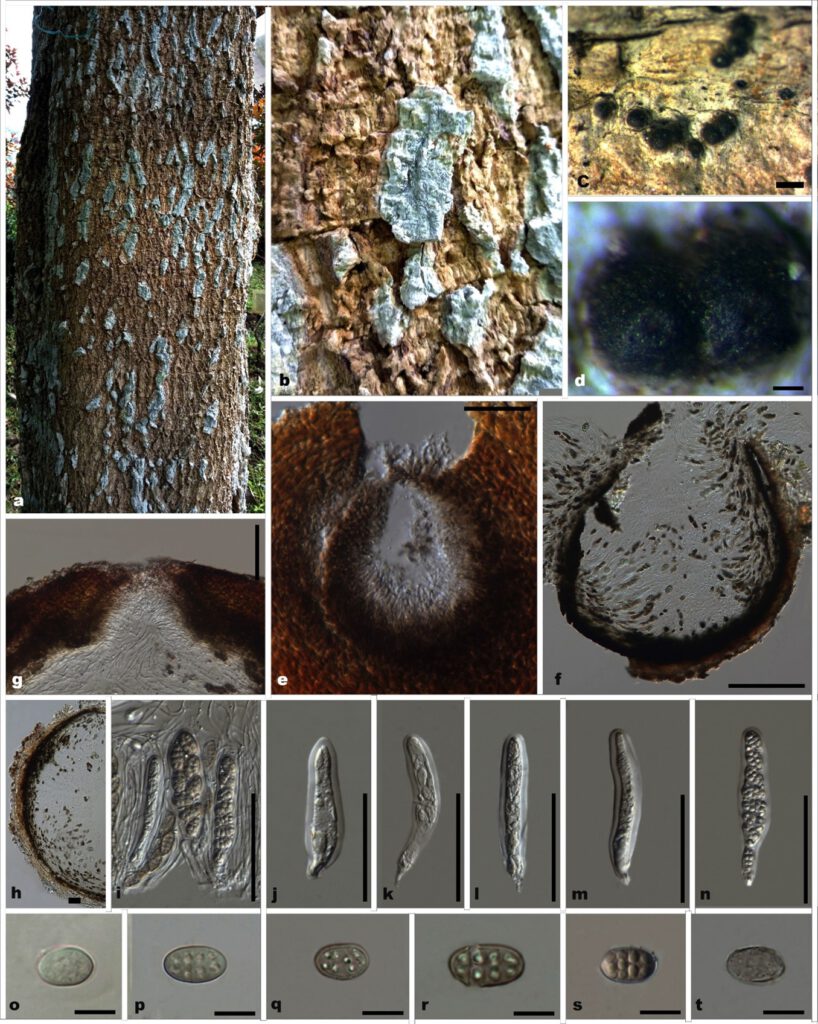Pyrenula ochraceoflava (Nyl.) R.C. Harris, Mem. N. Y. bot. Gdn 49: 96 (1989)
MycoBank number: MB 134434; Index Fungorum number: IF 134434; Facesoffungi number: FoF 10697; Fig. XX
Thallus epi peridermal, whitish, corticated, crustose, pruinose. Prothallus present, Photobiont observed. Sexual morph: Ascomata perithecial, 200–300 μm wide, 290–300 μm high, semi-immersed to erumpent, solitary to aggregated, coriaceous. Ostiole distinct, filled with paraphysoids. Peridium thickened, composed of two layers, Outer layer 14–24 μm thickness, brown, thicker at the upper, thinner at the base. Inner layer 6–16 t μm thickness, black. Hamathecium comprising filamentous paraphyses and asci, hyaline. Paraphyes 0.6–2 μm thickness, numerous, anastomosing, not branched, septate, hyaline, filamentous, generally exceeding the length of asci. Asci 60–80 × 10–24 µm (x = 70× 17 μm, n = 20), bitunicate, fissitunicate, long cylindrical, tholus thickened, tip blunted, with poorly developed stipe, ascus wall apically thickened, inconspicuous ocular chamber. Ascospores 10–17 × 6–9 µm (x = 13.5 × 7.5 μm, n = 40), 8-spored, hyaline to pale brown, ellipsoid, overlapping uniseriate to biseriate, both ends bluntly tapered, submuriform, with 4 tiers of 1-4 each loci, smooth-walled, without gelatinous sheath. Asexual morph: Undetermined
Material examined: Thailand, Mae Fah Luang Botanical Garden, Chiang Rai. On living bark of Alstonia scholaris (L.) R.Br. (Apocynaceae), 24 November 2019, Vinodhini Thiyagaraja, 50L (MFLU 21-0134)
GenBank numbers: ITS: OM320441, LSU: OM296115, mtSSU: OM304349
Notes: The new collection is phylogenetically closely related to P. ochraceoflava. The new collection shares similar morphological characteristics with P. ochraceoflava in the shape of ascomata (perithecial), ascomatal wall (orange brown outer layer, dark brown inner layer), central ostiole, simple paraphyses, absence of periphyses, asci (fissitunicate, 8-spored, elongate cylindrical, 60–80 × 10–24 µm size, inconspicuous ocular chamber) and ascospores (pale to medium brown, ellipsoid, submuriform). However, differs in slight morphological differences including thallus morphology as most species own pigmented thallus however whitish thallus with pruinose was observed in the new strain. Yet the shape and size of asci and ascospores are used as diagnostic characters for Pyrenula ochraceoflava (Aptroot 2012). The species are frequently recorded from tropical including India and Thailand (Makhija and Adawadkar 2001, Logesh et al. 2013, Aptroot 2012, Buaruang et al. 2017) and common in Cocos nucifera in Lakshadweep in India. Pyrenula ochraceoflava is first time recorded from Alstonia scholaris thus we introduce as a new host record.

Fig.3. Pyrenula ochraceoflava (MFLU 21-0134, new host record). a–d Ascomata on substrate, e, f Vertical section through ascoma, g Ostiole, h Peridium, i Paraphyses, j–n Asci, o–t Ascospores. Scale bars a–d = 100 µm, g = 50 µm, h = 30 µm, i–n = 50 µm, o–t = 10 µm
